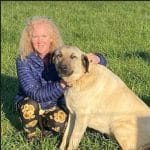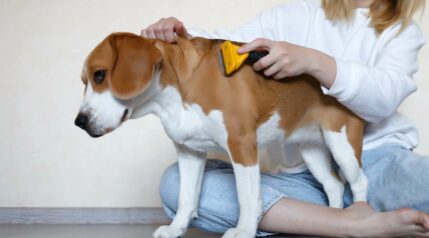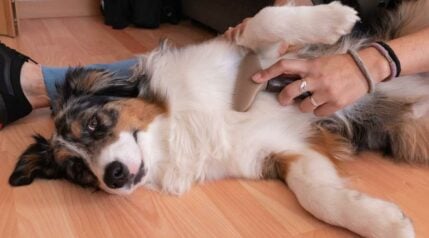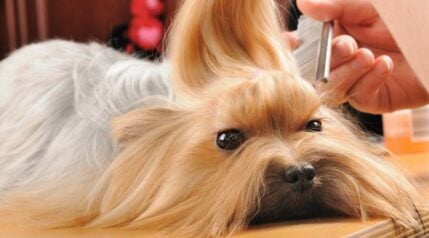A Great Dane’s imposing size and regal bearing leave quite an impression. You’ve decided you have the space for a dog his size, but you wonder if you can keep up with his shedding. He’s a big dog, with a lot of body. Danes are considered moderate to heavy shedders, but this is more due to size than hair type. Unless you need to limit the dog hair to a bare minimum, weekly brushing can keep a Great Dane sleek and his shedding under control for most of the year.
The Great Dane has a personality best described as “friendly, patient, and dependable.” He’s easygoing with his family but an alert guardian. Friendly and patient with children, his size makes him a challenge to keep. His short hair is easy to maintain, but with his size, there’s just a lot of hair, especially during shedding season. The elegant Great Dane sheds seasonally, so the time of year dictates how you care for his coat.
Whether there’s a member of your household with a dog allergy or you’re just trying to make sure you can keep up with his grooming, how you manage your Great Dane’s coat makes a difference. Here are some things to consider as you keep him healthy and minimize his shedding.
Great Dane Coats

Danes have a single coat, which means he has no insulating layer, even in winter. If he goes outside in the cold, he may need a blanket. If you can’t find the size to fit him, equestrian catalogs offer blankets in miniature horse size, and one of these may fit the bill.
The Great Dane’s smooth coat requires only minimal grooming. Currying him with a rubber curry or hound mitt and running over his coat with a soft bristle brush will handle most of the dirt and excess hair. Danes shed seasonally and have a summer and winter coat depending on the lengthening or shortening of the days. They shed most heavily when they lose their winter coat to prepare for summer’s longer, hotter days. You’ll need to brush him daily to manage the hair during shedding season.
Great Dane Colors
Great Danes are not only striking for their size but also their beautiful coloration. Danes may be brindle, fawn, blue, harlequin, black, merle, and mantle. The distinctive harlequin is white with black torn patches. The term mantle describes a pattern that looks like the dog is wearing a cape, or mantle, over his back. It is black and white with a black blanket extending over the body. His head is black with a white muzzle, an optional white blaze down his face, and a whole or partial white neck. He has a white chest, white on his forelegs and hindlegs, and a white-tipped black tail. The term merle describes a pale gray to dark gray merle base color with black torn patches within, and a Dane can be solid merle or merle with a mantle pattern.
Great Dane Shedding Frequency

Seasonal shedders shed when the days begin to shorten and when they begin to lengthen. You’ll notice some hair outside the two heaviest times of the year, but their coat is short and sleek. The hairs they leave behind are not as noticeable as on a long-haired dog.
As you may expect, as seasonal shedders, Great Danes shed most when they lose their heavier winter coat in mid to late spring. Change your grooming routine if your pup sheds more than you’d like during this transition. Curry him daily and bathe him to remove the old coat more quickly and minimize what falls in your home.
Hypoallergenic Dogs
You may have heard that some breeds are hypoallergenic, but any dog with hair can trigger an allergy. The proteins in your pet’s urine, saliva, or dead skin cells (known as dander), may cause people with pet allergies to have itchy, watery eyes or a stuffy nose. People with more severe allergies can become short of breath within fifteen to thirty minutes of inhaling these allergens. Sensitive people may also develop a rash on their face, neck, and upper chest.
If you have a family member allergic to pet dander, you want to find a breed with hair that won’t create health problems for your human family or a situation where you must rehome your pup. Great Danes are not hypoallergenic. They shed hair, and they shed dander. Remember that any breed, unless hairless, will shed and produce dander.
Other Reasons For Losing Hair
Shedding is normal, but abnormal shedding can indicate a health problem. Sometimes excessive shedding originates in the skin, also known as the dermis. Inflammation of the skin is called dermatitis (dermis=skin itis=inflammation) and can have a root cause that is either internal or external.
Genetic Causes Of Hair Loss
Great Danes are genetically prone to hypothyroidism and autoimmune thyroiditis, both causes of hair loss. If your dog seems to be shedding more than usual and shows patches of severe hair loss (alopecia), you need to examine the skin beneath the hair.
Danes are predisposed to a type of thyroid disease called autoimmune thyroiditis. This disease occurs when the immune system attacks the thyroid gland. Hypothyroidism and its associated symptoms (weight gain, lethargy, and hair loss) may be the only symptoms. Because autoimmune hypothyroiditis can itself be a symptom of more severe conditions, if you see symptoms of hypothyroidism in your pup, see your vet for a complete diagnosis.
Great Danes and other fast-growing large and giant breed dogs, including German Shepherds, Labrador Retrievers, Standard Poodles, and Doberman Pinschers, can suffer from Type 2 Zinc-responsive dermatosis. Both Type 1 and Type 2 ZRD cause skin lesions, including crusts and scaling around the eyes, mouth, and scrotum or vulva. They may develop a dry, dull coat that might or might not itch, and your Dane may have thick crusts on his foot pads.
If you see symptoms of ZRD, consult your vet for a diagnosis. Treatment may be as simple as switching food or ensuring any supplements don’t interfere with zinc uptake (take pictures of labels to show your vet). If this isn’t enough to alleviate his symptoms, your vet will put him on a zinc supplement that he’ll probably need for the rest of his life to keep his skin healthy.
External Causes Of Hair Loss
Several external causes of hair loss strike all dogs, regardless of breed. Parasitic causes of hair loss include demodectic mange, to which Great Danes may be more susceptible than other breeds. Pet owners may notice a few dry, irritated, hairless lesions in mild cases. These often occur on the face or feet and may or may not be itchy. Secondary skin infections may occur. Both fungal and bacterial infections of the skin can cause excessive shedding.
Flea bite dermatitis is the most common allergic skin disease in dogs. If you know you have a flea problem, putting together an effective flea management regimen is the first line of defense. If your buddy is still itchy after the fleas are gone, a visit with your vet is in order. They may perform a “skin scrape” and examine the sample under a microscope to decide the proper course of treatment.
The second most common allergic skin disease in dogs is more general. We call this skin allergy “atopy,” and Danes often have it. The feet, belly, and skin folds tend to be red and itchy, and ear infections become more common. Allergies typically appear when dogs are in early adulthood and can get worse every year. Licking the paws, rubbing the face, and frequent ear infections are the most common signs. The root of skin allergies is typically either environmental allergens or food sensitivity.
If you suspect your kibble is the source of your dog’s excessive itching and shedding, you might try a special diet with ingredients formulated not to trigger allergic reactions. Ask your vet what brands and formulas they recommend. You should be able to find a blend that keeps your buddy healthy and happy at a price point with which you can live.
Managing Great Dane’s Shedding
At A Glance

Best Conditioner
Zesty Paws Itch Soother
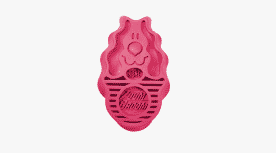
Best Rubber Brush
Kong Dog ZoomGroom

Best Soft Bristle Brush
ConairPRO Pet-It Boar
Note: Clicking the above links take you to each company’s website to learn more and get a quote. If you make a purchase, we earn a commission at no additional cost to you.
Even though Great Danes are a moderate shedding breed, they must be appropriately groomed. Choosing the suitable brushes for his short, fine hair ensures a pleasant grooming session for you both. Because he’s big and there’s a lot of body to groom, be sure to buy grooming tools that fit comfortably in your hand and your natural grip. Here are the best ways to manage their coat and reduce shedding.
Brushing
Your buddy’s individual coat and the time of year dictate how much you need to brush him. . When seasons change, your Great Dane will shed more than usual and will benefit from increased brushing. He could go days between brushings for the rest of the year but give him a once-over daily during spring and fall with a hound mitt or grooming glove to minimize shed hairs. He’ll feel like you’re just petting him, but you’ll improve the health of his skin by stimulating the production of natural oils and distributing them through his coat.
Types Of Brushes
Choose your grooming tools with care. A Great Dane’s short, slick hair grooms much like horsehair. A rubber curry, hound mitt, or grooming glove stimulates the production of oils in his skin. After the initial curry loosens hairs and distributes the oils through his coat, brush him with a soft bristle brush in short, quick strokes in the direction of the hair’s growth, and he’ll gleam with health.
Shampoo
Always choose a dog-safe shampoo. Choose a shampoo specifically formulated for sensitive skin if your pup’s skin reacts to be reactive. Even with a gentle shampoo, shampooing your Great Dane too frequently can strip the natural oils from his coat and dry his skin, so limit baths to once every few months or when he’s particularly dirty.
Diet
Your Dane’s coat directly reflects his health, and health begins with good nutrition. Feeding dog food that does not contain known allergens is the first building block of coat health. Many dogs are allergic to chicken in commercial dog foods. If you’re worried your pup may have a food sensitivity, try a chicken-free formula.
Nutritional deficiencies from lower-quality dog foods can also cause dermatitis and excessive shedding. Finding a quality food with ingredients your particular dog can tolerate may take some leg work at first, but it will save you money in additional supplements and vet bills in the long run. More importantly, it will keep your best friend from unnecessary discomfort.
The brand you choose should include omega-3 fatty acids. Omega-3 fatty acids have anti-inflammatory properties considered beneficial for dogs’ skin and coats. Research has shown omega-3s have health benefits for dogs beyond just making their coats shine. They reduce inflammation in the body, keeping your buddy more comfortable and keeping itchy skin at bay.
Supplements
Omega-3 supplements and treats make adding more omega fats into your Great Dane’s diet easy, and the goodies will overjoy him. Fish oils add omega-3s to promote a healthy coat and reduce shedding. Some supplements contain a blend of fish and plant-based oils to provide a balanced ratio of the three main types of omega-3 fatty acids, alpha-linolenic acid (ALA), eicosapentaenoic acid (EPA), and docosahexaenoic acid (DHA). If your Dane has food sensitivities, check the label on the treats to be sure you don’t introduce proteins to which he is sensitive.
Air Purification
You can minimize how much your Great Dane sheds with good nutrition and frequent grooming, but you can’t stop him from shedding. Adding air purification to your home has benefits beyond tackling dog hair, but it’s one more way to reduce the amount of hair in your home and the allergens in the air. The most significant allergen dogs introduce is dander, the dead skin cells constantly sloughing and falling along with shed hairs.
Dog dander is roughly 2.5 microns, although it may be larger. An air purifier that effectively eliminates airborne particulates smaller than this can significantly reduce the amount of pet dander available to trigger allergic symptoms. The Filtrete Air Purifier FAP-C03BA-G2 claims to capture 99.97% of airborne particles (as small as 0.3 microns), including dust, lint, dust mite debris, mold spores, pollen, pet dander, smoke, smog, bacteria, viruses, exhaust particles, and ultrafine particles. If you have a big dog, you may have a big house. You’ll need to see if one high-capacity unit or multiple smaller units suit the layout of your home.
Vacuuming
While vacuuming is nothing fun, it is one more tool in the arsenal against pet hair. If your air purifier eliminates the airborne particulates that trigger your allergies, a mechanical vacuum can take care of anything that lands on surfaces in your home or car. The best vacuum is lightweight so you’ll use it frequently and versatile enough to tackle multiple surfaces in your home and elsewhere.
While it is a traditional handheld stick vacuum, the Bissell Featherweight Cordless XRT also includes specialized pet tools. It converts to a handheld vacuum with a crevice tool and upholstery brush to get pet hair wherever it settles. This lightweight vacuum handles hard surfaces and area rugs but may not have the power for a home with wall-to-wall carpets. Carpet is a significant factor in how much hair and dander stay trapped in a room. You may consider the more powerful Bissell ICONPet Edge for fully carpeted homes.
Frequently Asked Questions
Do Great Danes Shed A Lot?
Compared to other breeds of dogs, Great Danes are moderate shedders. Their surface area pushes them towards the heavy category just because there’s a lot of body to shed. Depending on the season, you’ll notice a difference in how much hair he loses. You can increase the frequency you brush him to help his coat shed out more quickly.
When Is It Time To Take My Great Dane To The Vet?
If your dog is shedding more than expected, inspect the skin beneath his coat. If you notice that his skin seems thick, greasy, scaly, red, or foul-smelling, schedule a consultation with your veterinarian.
Final Thoughts
Nobody brings a Great Dane into their life unless they are ready for the responsibility of a large dog. You’ve checked your list, and you have the space, the fenced yard, the time for walks, and room in the car to transport him to and from the vet. Relative to the other considerations, his shedding will be relatively manageable.
Care for your Great Dane’s coat with the proper tools and the occasional mild shampoo. Feed him a quality diet with omega-3 fatty acids to reduce inflammation and keep his skin healthy from the inside out. Shedding is normal for a Dane, and there’s a lot of him to shed. With proper management, you’ll be able to handle the shedding and focus on the big love your giant companion brings to your life.
